Human Flower Project
Friday, April 25, 2008
A Tall Order—Large Stature Trees
What lengths would you go to for shade, good drainage, and year ‘round beauty? Urban arborist Georgia Silvera Seamans explains the benefits of tall trees and ways to plant these giants successfully in cities. Thank you, Georgia.
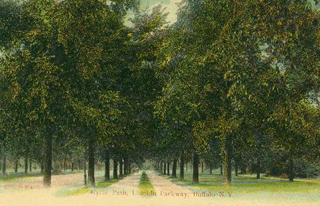
Cycle path, Lincoln Parkway, Buffalo
Source: Heartland
The “Right Tree in the Right Place” (RTRP) concept encourages municipalities, NGOs, and homeowners to plant trees shorter than 25 feet under overhead utility lines. The crowns of large stature trees, encroaching on wires, can cause a number of problems: downed branches that interrupt utility service, tree trimmers’ perilous contact with live wires, and the conventional pruning of tree crowns into U-shapes (these tend to be structurally unsound and are nearly always unattractive).
Consequently, following RTRP along roads and in neighborhoods with overhead wires yields a short canopy. Redbud, purpleleaf plum, crape myrtle, “flowering” cherry, crabapple, Japanese lilac, and trident and hedge maples, these small stature trees both look and function differently than do streetscapes of large trees like elm, London plane tree, sweet gum, tulip tree, ginkgo, oak, and linden.
Let’s consider some of those differences.
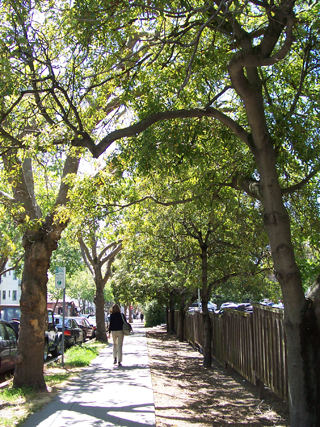 Setback trees on private property create sidewalk shade. Berkeley, CA.
Setback trees on private property create sidewalk shade. Berkeley, CA.
Photo: Georgia Silvera Seamans
The aesthetic contribution of short stature trees tends to be limited to their flowering season, while the arching canopy effect of larger stature trees is a year-round feature. Also, short canopies, while beneficial to wildlife, produce smaller ecosystem benefits. (See “Street Trees: Let’s Think Outside the Wires.” Short stature trees have tremendous habitat and food value. Take urban birds. They utilize different layers of the urban forest canopy. As Julie Zickefoose writes in Natural Gardening for Birds, short stature hawthorns provide berries, while larger stature ashes and locusts provide nesting.)
Here are other benefits provided by larger stature trees:
• They provide more shade for infrastructure like streets: “shade on the street segment with large-stature trees will reduce costs for repaving by $2,900 (58%) over the 30-year period compared to the unshaded street. Shade from the small-stature trees is projected to save only $829 (17%)” (From Why Shade Streets? by the Center for Urban Forest Research, 2006).
• In terms of air pollution, “the annual net reductions for pollutants range from 10.1 lbs for a 40-year-old large tree to 0.7 lbs for a 40-year-old small tree. And values range from $64 for a 40-year-old large tree to $1.62 for a 40-year-old small tree” (Center for Urban Forest Research, newsletter, January 2005).
To learn more, here are three good resources (al pdf files): the CUFR’s 2003 newsletter “The case for the large tree”; 2001 Factsheet #1 about the benefits of large front yard trees; and Dr. Greg McPherson’s 2003 article, “A benefit–cost analysis of ten street tree species in Modesto, California, U.S.,” published in the Journal of Arboriculture.
Another deficit of the Right Tree for the Right Place formulation is its ignorance of design factors. Street trees are typically planted at the street edge of the sidewalk. Wires are generally sited towards the edge of the sidewalk, too. With this inevitable conflict for over space, streets with overhead wires are usually planted with short stature trees. But, street trees could be planted on the building side of the sidewalk or in front yards (preferably through an easement so that the city has some oversight about removals). There are actually several such “setback” programs in the U.S. The City of Boston Parks Department sponsors one, (and is enabled to do so according to Massachusetts General Law). Public trees can be planted on private property as long as they are within 15 feet of the public right of way. EarthWorks Projects in Boston, MA, initiated the Setback Trees Project in 2007, self-described as planting “trees on private property for the common good.”
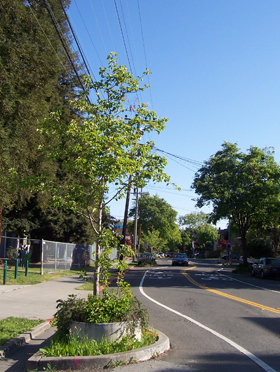 Bumpout (note this bumpout is not connected to the sidewalk) – tree is just outside overhead wires. Berkeley, CA
Bumpout (note this bumpout is not connected to the sidewalk) – tree is just outside overhead wires. Berkeley, CA
Photo: Georgia Silvera Seamans
There are other design possibilities. Trees could be planted in bump-outs located beyond overhead wires, in traffic circles at neighborhood intersections, or in the center of neighborhood blocks (see photo below). (Traffic calming is one co-benefit of planting trees in the center of the roadway or at an intersection.)
And overhead wires could be buried. This is an expensive proposition; according to The Seattle Times, the cost to the city of burying utility wires for a local project was $350-$400 per linear foot. In another Washington community, the cost of burying electric, phone, and cable wires was estimated at $2500 per foot.
However, tall urban street canopies provide considerable benefits long-term. The conflict between large stature trees and overhead wires is not new. In his fascinating book, Republic of Shade, about the American elm (Ulmus americana) in New England, Thomas J. Campanella describes anti-elm sentiments expressed in an 1853 article from the New York Times:
“Most American cities were in urgent need of a pruning. Larger, ‘weedy’ species should be removed at once, (the Times writer) argued, and replaced with smaller trees ‘of a character that can be trained around the wires.’ Elms, very big and very weedy, must be sacrificed to appease the goddess of electricity.”
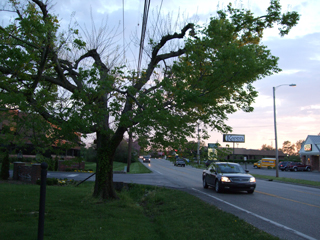 Appeasing the gods of electricity: large trees pruned into u’s under wires on Old Brownsboro Road, Louisville, KY
Appeasing the gods of electricity: large trees pruned into u’s under wires on Old Brownsboro Road, Louisville, KY
Photo: Human Flower Project
Campanella also notes that changes in road technology affected trees. Street surfaces before 1890 did not restrict “the passage of water, nutrients, or oxygen to the roots of adjacent trees,” but asphalt and concrete paving “virtually sealed the surface of the street,” depriving trees of all three.
Another dimension of “Right Tree in the Right Place” is to select species according to the size of the growing area—most often the square foot of the sidewalk cutout or width of the tree lawn (the grass strip located within the sidewalk). This is a very reasonable concept. Healthy trees depend on adequate root systems, which requires sufficient area to grow. Often, according to landscape architect and arborist James Urban, we look up at tree crowns and ignore what’s happening below ground.
Different cities have different standards. In the City of Boston, the minimum tree well area is 24 square feet, often a 3×8 foot or 4×6 foot sidewalk cutout. One East Bay, California city’s minimum standard is 2×2 feet or 4 square feet! Generally speaking, a foot of root area supports an inch of trunk diameter. Accordingly, at only four inches in diameter at breast height, a tree with a well area of 4 square feet has maximized the initial growing area for its root system. This tree will seek additional space either within the sidewalk (made visible by buckling) or in someone’s front yard.
A small cutout clearly will restrict the size of the tree that can be planted initially. For example, a 2×2 foot area cannot adequately accommodate a tree that is two inches in diameter whose root ball is two feet in diameter. On average, for every diameter inch at planting, a tree needs a year to establish. So, a two inch tree will take two years to establish. Although, a 15-gallon tree (the size frequently planted in a 2×2 foot cutout) will establish faster, its aesthetic and functional presence is less significant than a larger diameter tree.
The 2×2 foot area is the minimum, so presumably a larger growing area will be provided if the sidewalk can accommodate it. Although a 3×8 or 4×6 space is significantly larger, it can only support a 24-inch diameter tree within the original cutout. Ideally, street trees would be given larger growing areas for their root systems. However, if the sidewalk is space constrained (Americans with Disabilities law requires four feet of clearance for accessibility), what are the options?
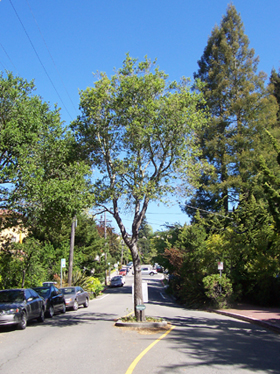 Annie’s Oak, Berkeley, CA
Annie’s Oak, Berkeley, CA
Photo: Georgia Silvera Seamans
One option is to install structural soil beneath the sidewalk. Structural soil is an engineered medium that supports root growth while simultaneously satisfying engineering load-bearing requirements. The most well known structural soil recipe was developed by Cornell University’s Urban Horticulture Institute. An older version of structural soil is sand-based, also known as Amsterdam structural soil. The most significant difference is that CU soils can achieve a greater level of compaction (important for load bearing) and still sustain root systems than can the Amsterdam soil – 95% versus 85-90%. The installation of structural soils could be undertaken as sidewalks are repaired, redone, or created. Like the burying of overhead utility wires, this solution is costly, but again, the potential benefits to a city, its trees, streets and people are significant.




